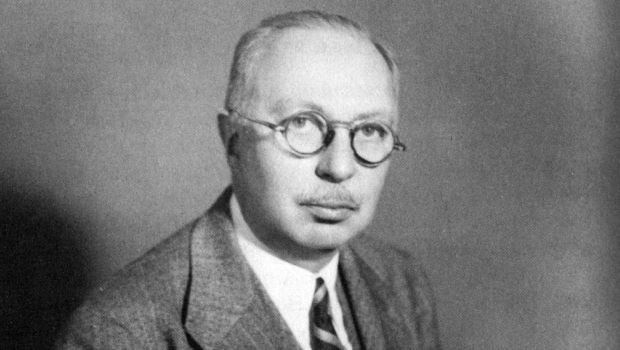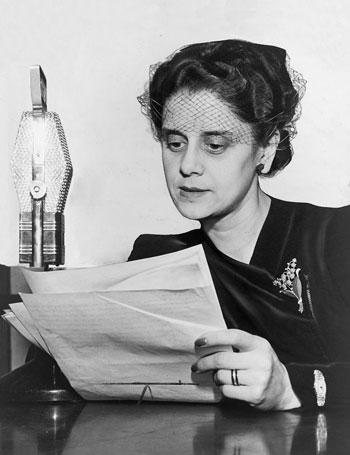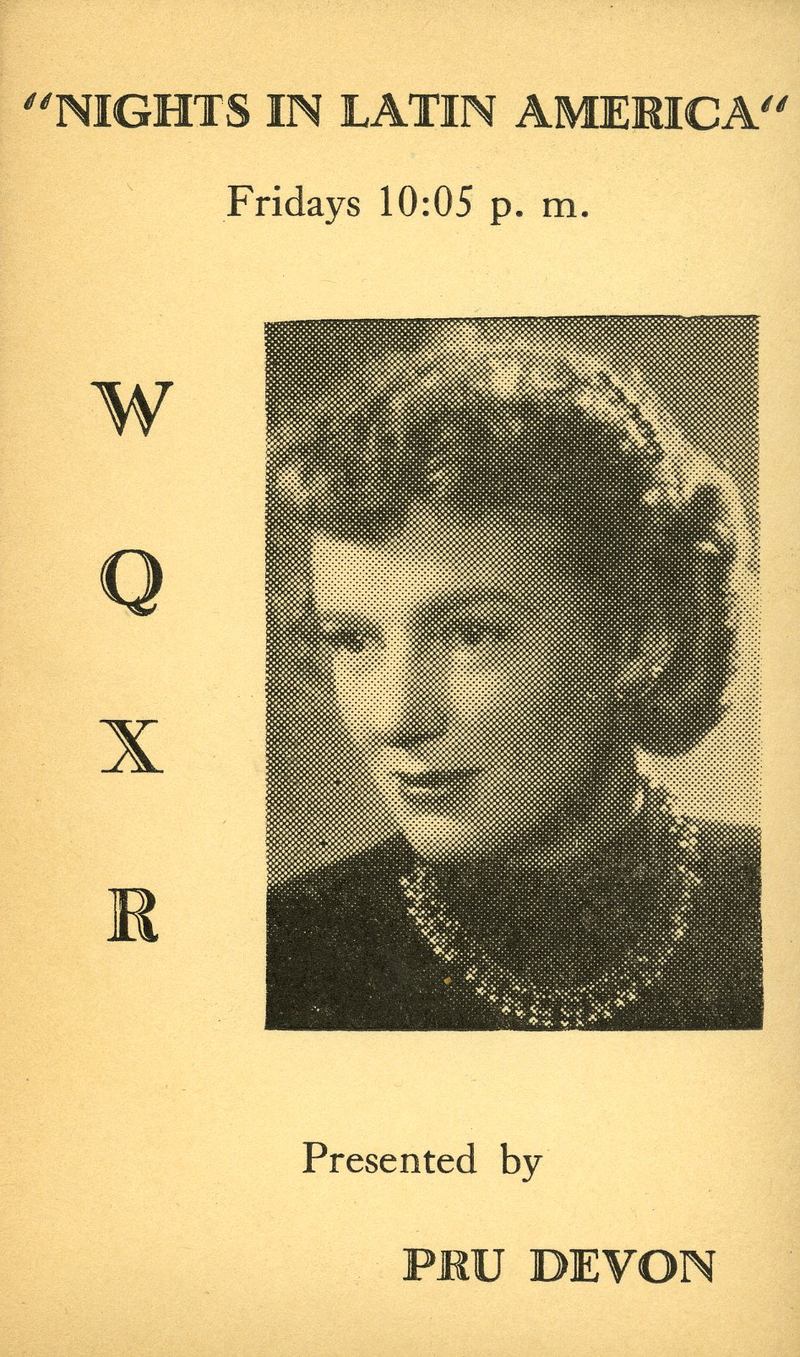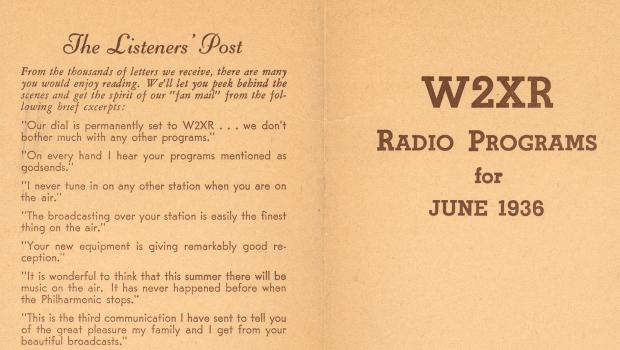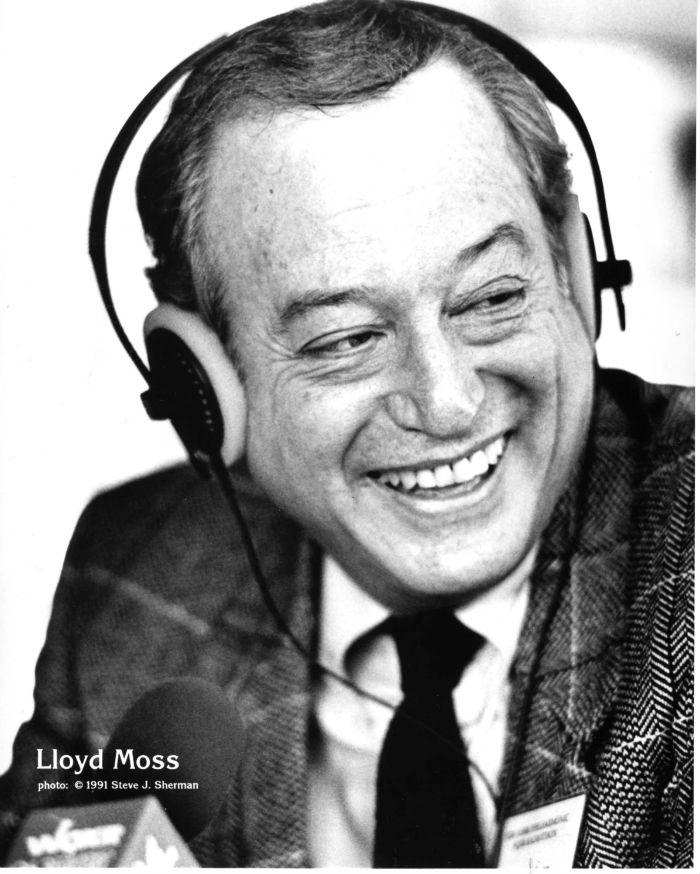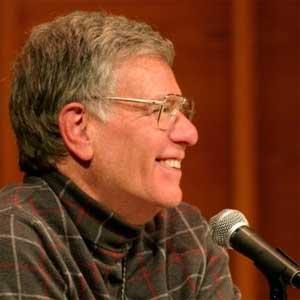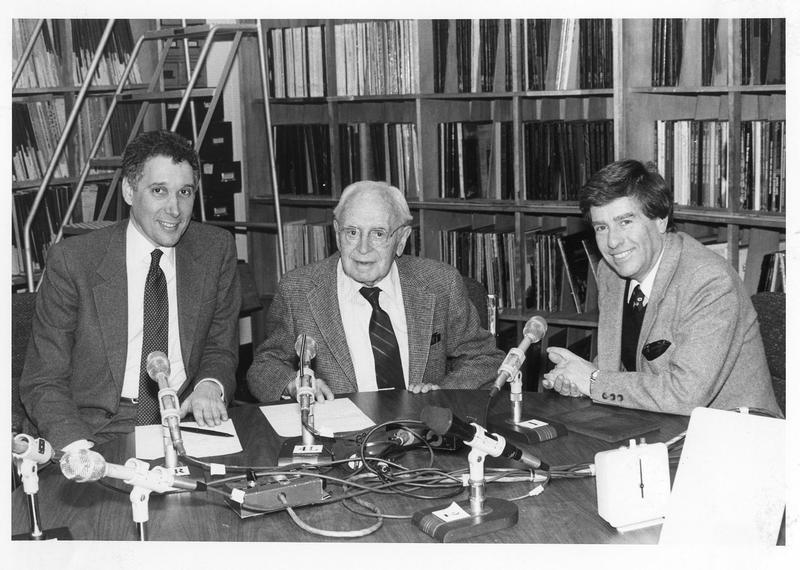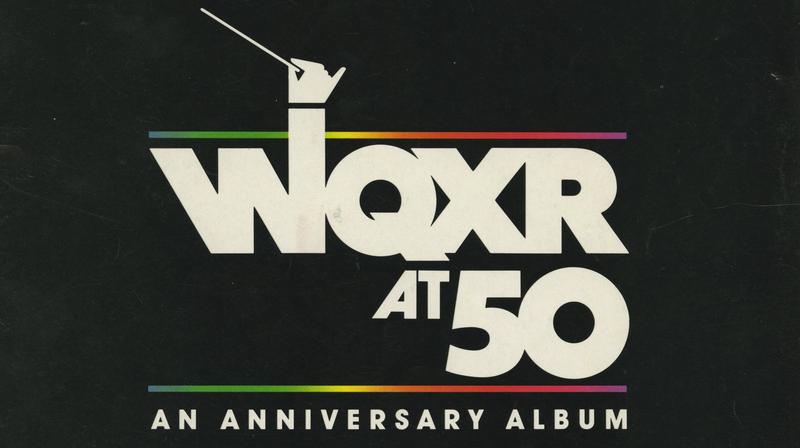A Short History of WQXR
The Early Years
Fittingly for a station whose pioneering pedigree is embedded in its name (the X is for "Experimental"), WQXR has been responsible for an impressive number of radio “firsts”—first to go "hifi" (in 1936), first to use tape on the air (1938), first to broadcast in FM (1939), and first New York station to experiment with “stereo” (1952)—but just one first-and-only:
Founded in 1929 by John Vincent Lawless Hogan, W2XR, future radio voice of the New York Times and for years one of the most renowned radio stations in the country, was the first radio station to begin its existence with a television broadcast.
The world wasn’t ready for TV on the radio in 1929, but it was wild for wireless, and Hogan, a former aide-de-camp of radio trailblazer Lee de Forest, was particularly well-positioned to lift the medium to new heights. W2XR received its first license in 1934, which cleared it for non-commercial broadcasts. When Hogan partnered with his old friend, Elliott M. Sanger, to form the Interstate Broadcasting Co., Inc. (IBC) two years later, venturing into commercial radio, it got a literal boost: WQXR increased their output by a factor of 4, quadrupling their wattage from 250 to 1000. The new commercial licence also forced them to change their name from W2XR to WQXR—2 to Q, it rhymed.
The new station grew rapidly over its first few months, fast becoming one of the most popular stations in the City, and seizing the opportunities available to the engineering innovator it was. Taking advantage of its double-the-standard bandwidth, WQXR pushed their sound to the air in “high fidelity.” Their “program guide,” a proto-music magazine, quickly became a unique and popular favorite. And in 1939, Edwin H. Armstrong selected WQXR as the test case for his new means for broadcasting, making them the first to hit the air on the FM band. The station was progressive not only technically, but socially: early personalities to enjoy airtime on WQXR included former ACLU director Quincy Howe, the pioneering Lisa Sergio, and Bennett “Books Are Bullets” Cerf, among others.
The New York Times
The IBC’s 1936 application to the FCC stated that the station would “try to emulate the standards of the [New York] Times.” In this they apparently succeeded: on January 25, 1944 the New York Times purchased WQXR for the princely sum of one million dollars, though for contractual reasons, the Times programming wouldn’t appear on WQXR airwaves for another two years.
WQXR’s relationship with the Times would be a boon to the city, the station, and the paper, particularly in situations where news simply could not wait the night—listeners knew it was Truman Defeats Dewey, not the other way around—and in other times of crisis, as when New York experienced a newspaper strike in 1963. During those tumultuous 114 days, WQXR capably buoyed the City’s temporarily lost Times, doubling its news broadcasts and drawing in more than a few non-striking reporters, ultimately earning the station's fourth Peabody (of six) for their work. WQXR’s early innovations did not cease either: on October 29, 1952, it would give its many listeners their first experience with the binaural, an early taste of stereo. Those tuning in would set two radios 6 feet apart, one tuned to AM, the other FM, and bask in the nascent novelty that would revolutionize the world of radio and recorded sound.
During its time as the "Radio Station of the New York Times", listeners would hear from such personalities as Edward Bernays, Bob Hope, Evans Clark, Alistair Cooke, Van Cliburn, and June LeBell on a wide variety of programming: news and talk, music—symphonic to South American—and more.
Today
After first mooting the sale of WQXR in 1971, the New York Times would finally part ways with the station on July 14, 2009, when they sold it to its present grateful owners, New York Public Radio, Inc. Today, WQXR broadcasts a variety of classical music programming, including Performance Today, Young Artists Showcase, Reflections from the Keyboard, and the 2016 Peabody Award winning Meet the Composer.
The Collections
Collected here are some of the series digitized as part of a 2011 grant from the Grammy Foundation—Great Artists, This Is My Music, Vocal Scene, and WQXR at 50: an Anniversary Album—as well of a collection of essays published in WQXR's popular Program Guide. This is My Music and Vocal Scene are represented here as selections "From the Archives," a 2013 victory lap taken by WQXR to promote their archival collections.
Program Guide Essays
For years WQXR invited noted composers, conductors, music educators, critics, philosophers, news commentators, and lyricists to write essays on a variety of music and radio related topics for the WQXR Program Guide. Extant selections published between 1941 and 1944 have been collected here for your reading pleasure. Guest writers include tune detective and musicologist Sigmund Spaeth, songman Irving Caesar, composer Aaron Copland, Edward Johnson of the Met Opera, Juilliard's Ernest Hutcheson, conductor Thomas Beecham, and philosopher Irwin Edman. Non-guest writers (those on the payroll) include WQXR founders John Hogan and Elliot Sanger, and ACLU alum and WQXR news commentator Quincy Howe. You can read too WQXR editors spilling vitriol on the distractions of "singing commercials," and scan the compilation of hate mail from the fall-out of their broadcast of the modernist Alben Berg. And there are at least a few small nods to diversity, with Beecham's misogynistic screed thankfully tempered by appearances from Helen H. Hull of the Philharmonic Symphony Society, pianist Olga Samaroff, and WQXR's pioneering feminist Lisa Sergio.
This Is My Music
A forerunner to WQXR's Mad About Music and WNYC's similar Survival Kit, This Is My Music aired on WQXR from 1979-1987. Hosted by Lloyd Moss, it featured well-known celebrities, artists, writers, performers, academics and politicians discussing the music they prized most and songs, sounds, and symphonies that had most influenced them through the years. Interviewees would also listen to selected items from their list of favorites. Among the show's guests were Robert Moog, Gore Vidal, Benny Goodman, E. L. Doctorow, John Simon, Glenda Jackson, Bella Abzug, Marian Seldes, Malcolm Forbes, Eartha Kitt, Andrew Lloyd Webber, Judith Jamison, Tony Bennett, Gloria Vanderbilt, Charles Aznavour, Alan Dershowitz, Maurice Sendak, Leo Rosten, and Marcel Marceau. Due to music copyright issues, these broadcasts are not currently posted on our website, but appearances by Marvin Hamlisch and Barbara Cook were included as part of our 2013 From the WQXR Archives series, as was an episode of First Hearing, one of Moss' other programs, and the Vocal Scene, below.
The Vocal Scene
George Jellinek, WQXR's music director from 1968 to 1984, for over 35 years hosted a weekly show program, The Vocal Scene, dedicated to the finest in vocal music. It first show went on the air on January 1, 1969, and the following year the program was syndicated to other classical stations, increasing Jellinek’s influence and fan base well beyond the broadcast radius of WQXR. An apparently giving spirit, he presented recordings made by not only the most prominent of vocal artists, but also many who had not yet found fame (and perhaps never did), introducing singers who were less well-known to his expansive audiences.
A record collector since his boyhood, Jellinek cultivated an intimate familiarity with the great voices that had been preserved at the beginning of the era of sound recording, and his knowledge of the rich history of vocal music greatly informed his understanding of the brilliance and variety of real vocal artistry. He shared those recordings and that understanding on The Vocal Scene. He interviewed great singers of the day, and, never betraying the promise of the program, reached beyond strictly opera to showcase Lieder, operetta, zarzuela, and more.
As with This Is My Music, music copyright issues prevent the posting of the full series, but several episodes were included as part of our 2013 From the WQXR Archives series, collected here.
Great Artists
The WQXR Great Artists Series contains dozens of fascinating interviews with leaders in the fields of music, film, and the performing arts. Its host, Robert Sherman, was (and is) a music critic and columnist for the New York Times for over forty years, and served on the faculty of the Juilliard School for Music for nearly twenty. In this series, which aired from 1977 to 1985, Sherman speaks with musicians, artists, and performers including George Balanchine, Samuel Barber, Ray Bolger, Dave Brubeck, Betty Comden, Alicia De Larrocha, Benny Goodman, Alfred Hitchcock, Robert Joffrey, Erich Leinsdorf, Zubin Mehta, Ned Rorem, Mstislav Rostropovich, Michael Tilson Thomas, and more. The scintillating discussions frequently include musical segments directly related to the interviews, and the collection as a whole provides a fantastic insight into the worlds of the arts in the latter half of the twentieth century.
WQXR at 50, an Anniversary Album
In 1986, Sherman was tasked with a great undertaking: to cull through the station's tapes, cassettes, lacquer discs and assorted ephemera and create a 26-episode series encapsulating the 50 year history of WQXR.
Through an assemblage of clips, stories, interviews, oral histories, and—above all—music, Sherman created hour-long programs called "WQXR at 50, an Anniversary Album". The programs include some of the earliest historical moments in the collection, including a 1937 excerpt from talks by WQXR cofounder John Hogan. In a New York Times article from July 8th, 1986, Sherman spoke enthusiastically about the special anniversary program:
"We have an interview with Sir Thomas Beechman on 'Happiness in Music.' We have William Schuman honoring Serge Koussevitzky on the day the noted conductor died. We have a very funny and typical program with Alec Templeton, the blind pianist and humorist. Martyn Green speaks of his days with the D'Oyly Carte company. Abram Chasins interviews Fritz Kreisler on Kreisler's 80th birthday and reads tributes to the great violinist from such colleagues as Mischa Elman, Joseph Szigete, Isaac Stern and Jascha Heifetz. Alicia Markova talks about Giselle, Stravinsky about Orpheus."

